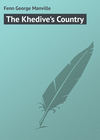Читать книгу: «The Khedive's Country», страница 3
Chapter Five
In a country which depends upon floods and their deposit for its fertility, one of the first questions likely to be asked by a practical man is, What about the drains? He knows perfectly well, from reading and report, that the evaporation of the waters that have for the time being turned vast tracts of land literally into swamps must be enormous, but at the same time some plan for carrying off the superabundant moisture must be in force. Let him learn at once that in Egyptian agriculture there are no underground tiled drains in use; but open ones are formed upon land that requires improving, such as the rice fields and those which, when cultivation has commenced, are found to be impregnated with salts, while a great deal is done by the Government, under whose direction large main cuts are dug to drain off the water on low-lying lands.
On the rich soils water may be lying to a depth of four inches after a flood, but it is so readily absorbed that in six hours none will be left on the Surface; but infiltration from irrigation canals sometimes damages the crops alongside, and in such a case as that a small catch drain will prevent further mischief.
With regard to irrigation, two systems are carried out, the one peculiar to Lower Egypt, the other being utilised in Upper. In Lower Egypt the canal is used for the supply of water to the crops. In Upper Egypt the manner adopted is technically termed the “basin system.”
In this latter method embankments are formed to enclose tracts of land well within reach of the Nile flood, which may contain from two thousand to forty thousand acres, according to the means of, or facilities offered to, the agriculturist. Afterwards the proceedings are exceedingly simple. When the inundation is at its greatest height, openings are made and the water is allowed to flow from the river till the sandy surface is covered to a depth of six feet. Then the matter, suspended in the muddy waters, is slowly deposited and goes on sinking till November, when openings are made into canals, and the water is allowed to slowly drain off and make its way back into the river, when the surface of glistening mud that is left is considered ripe for cultivation, and according to the season may measure perhaps four inches in depth.
As soon as the water is gone, the farming operations begin, and in the simplest and probably the oldest form. There is nothing more to be done in these cases, no ploughing or harrowing; but wheat, barley, beans, clover, linseed, and lentils are sown broadcast by the patient labourers, the sowers often sinking knee deep in the mud as they slowly plod or almost wade to and fro. The next proceeding is the burying of the seed, which is generally effected by drawing a large beam of timber over the muddy surface, though at times, when the consistency is greater, the seed is covered in by hand-hoeing. That is all, and the agriculturist leaves the rest for the time being to the efforts of the sun. Germination soon begins, and rapid growth succeeds in the moist mud; while these crops do not need or receive any further irrigation except from rain, which may fall two or three times in the course of growth.
But there are times when no rain at all will come to help the crops, which, however, seem to suffer very little, from the simple fact that the thorough saturation of the subsoil by the flood, and the constant gentle evaporation going on, make up to a certain extent for the want of genial showers, and the failure seems to be confined to the straw alone, which is shorter than if its growth had been influenced by the dropping clouds.
The floods of European lands are, of course, only occasional, accidents due to a prevalence of storm waters, which the regular rivers and the artificial drainage of the country have not power to carry off; while generally they last but a short time, and instead of being beneficial are destructive. The Nile flow is in every respect the reverse. Instead of being occasional and of short duration, it is a part of Nature’s routine, and perfectly wondrous in its regularity; while in place of being temporary, as in the floods of our own islands, we have here a lasting overflow.
Again, a flood in the British Islands, where the rivers burst their banks and spread over meadow-land and arable fields, leaves the soil soured, sodden, and obnoxious to the plants which are still alive, whole crops and plantations being often swept away, while those that remain are on the high road to perishing from rottenness.
In Egypt the subsoil of sand is ready to absorb, and the ardent sun to rapidly dry, the surface of the mud as soon as the flood sinks, after its stay of months; while the rapidity of growth soon makes up for the, so to speak, dormant state of the cultivated ground that has been flooded, and, as aforesaid, the water departs, leaving its fertilising riches behind. Then, as stated, follows without further tilling the sowing of the crops, which result in abundant growth. This annual regularity is only marred by the extent of the inundation, which is calculated and divided by the Egyptians into high flood, mean flood, and poor flood, according to how far the waters extend when they leave their natural bed.
It is calculated that in the first case, when the Nile has reached its highest point, it has risen to thirty-three feet; in the second case, the mean flood, thirty feet; and in the third, or poor flood, twenty-three feet above its bed. As a matter of course, the higher the flood the wider spread is the inundation, and the deeper the deposit of fertile mud left upon the land when the river has returned to its ordinary limits.
Stay-at-home people are accustomed to look upon Holland as the land of canals, and the face of this carefully cultivated country is monumental as a specimen of a nation’s industry in cutting waterways for the double purpose of draining and traffic, while its drains are as admirable as they are great. Wide tracts of land have been turned from sandy wastes and swamps into fertile meadows and carefully cultivated fields by the Dutch engineers, who have also left traces of their handiwork upon the east coast of England in the drainage of the fens.
But, leaving the supposed canals of the planet Mars to the imaginations of astronomers, it is safe to say that Egypt bears off the palm for works of this description. The ancients knew of their value, and enormous cuts were made by the help of slave labour, and were left to survive the rolling away of centuries, and where not duly cared for, and filled up by the drifting sand, have lain ready to be cleared out, deepened and brought into use again. These have been added to, till at the present time it can be said that the system of canals connected with the main river for the purposes of portage and for perennial irrigation cannot be equalled anywhere in the world.
The barrage of the Delta is of incalculable value, since by closing the sluices the head of water is raised and irrigation made more easy, while the works of this description lately carried out upon the Nile at Assiout and Assouan conserve immense bodies of water, which have formerly flowed regularly down to the sea, carrying with them millions of tons of fertilising mud or warp, with the equatorial washings of the rich, untrodden land. This solution of plant-making soil has gone on downward towards the sea from untold ages, forming by degrees the vast Delta, beside that which was lost to the service of man, merely choking up and making shallow the many watercourses into which the Nile waters have been broken up, and altering the positions of ancient ports and maritime cities now distant from the sea.
Chapter Six
A good old English gardener once said, “You can’t grow things well without plenty of manure,” and this the Egyptians found out years ago. They have the great advantage of the fertile mud deposited by the river, but to bring it to its highest state of production land seems to ask for the crude form of animal plant food as well as the vegetable and mineral.
It is to be presumed that there must be a great deal of vegetable fertilisation swept down by the Nile in a decayed state from the forests and swamps of Central Africa, but Egypt itself is no land of forests and that wondrous help to vegetation, leaf mould, may be said to be entirely absent, while the ordinary animal excreta so carefully collected in most civilised countries for application to the land is sadly wanted and neglected here for farm and garden purposes. It is carefully collected, it is true, and dried; but here, in a country where wood is exceedingly scarce, it is used for fuel.
As a rule, the resulting ashes are regarded as of little worth, whereas they contain, in a mineral form, so many of the constituents of vegetable life that, if preserved, they would be most valuable. In fact, the fellaheen look upon the ashes in the same light as they are regarded here in England, if they are thought of at all, as a coarse ingredient to mix with a clayey soil to lighten it in the place of sand. But in these islands there is the excuse that for the most part they are coal ashes and wanting in fertilising powers. Where they are wood or vegetable ashes the English cultivator has long known their value from the extent to which they are impregnated with potash. Still, there can be no doubt that the ash of the Egyptian fuel, though not returned to the earth in a well-thought-out and business-like way, does play its part to some extent in restoring exhausted soil.
The term “farmyard manure” is common of application, but an English farmer would look at it in amazement and not know his good old friend again, for the Egyptian farmyard manure seems to have been invented by the sanitarians of our dry earth system, being composed of desiccated Nile mud which has been carefully spread over the floors of the cattle-sheds as litter wherever bullocks, cows, horses, sheep, etc., are kept.
In this fine, dry state, the once mud, now earth, is remarkably absorbent and sweetening; most healthy, too, for the animals, who are not seen here trampling nearly knee deep in the soon-made foetid swamp of a country crew-yard. Moreover the earth is frequently removed – to be kept lying in the manure heap for about a year to mature, when it is considered ready for use, and the cattle enclosures and sheds of a farm are remarkably wholesome and clean.
This dry mud is one great source of plant food for the farm, but it is largely supplemented by what the Egyptians term coufri, or sabbakh. This is not always available, and depends upon the position of the farm; but there are parts of the Delta where, to all appearance, the tract being reclaimed or taken up for bringing into cultivation is so much level, or nearly level, land, with a mound or slight elevation here and there where the winds have drifted the sand apparently to a considerable depth. Except to the eye of the experienced there is nothing to show that flourishing cities and villages have existed there in the past; but many of these slight elevations are the sites where teeming populations once existed, and all has gone back, with some few exceptions – dust to dust. The exceptions are where the spade of the fellah comes upon the remains of a tomb or priestly edifice, these, as is well-known, being the lasting part of man’s work, which are being discovered constantly even now, with their builders’, sculptors’, and painters’ handiwork looking, when the sand has been removed, almost as fresh and uninjured as if they were the traces of two or three generations back instead of having been buried many centuries ago.
These solid remains, or ruins, may be comparatively few; but in all probability have been surrounded by an enormous population, whose houses, originally built of the sun-dried Egyptian brick, have in the course of time gone back, like everything animal that surrounded them, to a rough earth ready for the worker’s spade, which digs up from an almost inexhaustible mine – with nothing to tell of the past but a few broken shards – a splendid fertiliser for the farm.
But this coufri manure requires discrimination in its use, too strong an application being likely to prove hurtful to a crop, seeing that analysis shows that its plant-feeding qualities are due to the salts it contains – sometimes as much as 12 per cent, of salt, soda, ammonia, saltpetre, phosphates, and the like.
The value to an English farmer of such a mine of artificial chemical manure as this may be conceived, and it would make the eyes brighten of one here who strengthens his land by applications of marl, or else has to content himself with a top dressing of chalk from some pit sunk in a corner of his holding.
Fairly plentiful still in Egypt, there must, of course, be a limit to this supply. The taking up of land is going steadily on, and consequently the remains of city after city have been and are being rapidly used up, thus necessitating the establishment of plans upon a practical basis for the restoration of land which should not be exhausted by heavy crops without the cultivator making a proper return. One of our students of agriculture, in a public address, deals largely with the necessity for the dissemination of a practical knowledge of the needs of the land. He speaks of the great waste of fertilising matter in the way in which the refuse stalks of two of the greatest crops of the Delta – cotton and sugar-cane – are burned in the furnaces of engines, for which purpose they are most valuable when it is taken into consideration that fuel wood is a rarity and coal a luxury of exorbitant price.
But after burning, so ignorant have the people been, that the tons upon tons in the aggregate of this rich ash from the engine fires which consume the refuse of the enormous crops of sugar-cane annually grown, have been looked upon as comparatively valueless, in spite of the fact that the ash contains almost all that is required for the growth of so exhaustive a crop, and it has been either cast away or sold for a trifle, to be used up in the manufacture of bricks. He adds, in words full of pregnant meaning, that even the fertile alluvium of the Nile Valley cannot long sustain this treatment without exhaustion, in spite of the much that is done by the feeding off and ploughing in of the leguminous crops, which play a great part in giving back what has been taken away.
Farms here, too, are often found with a large dovecote, as alluded to in the description of the Khedive’s estates; for the Egyptian cultivator has a fine substitute for the guano of the Peruvian Chincha Islands in that of the pigeons which are kept in flocks for the sake of this strong fertiliser. Undoubtedly they must take severe toll from the crops, whether green or fit for harvesting, though perhaps this is counterbalanced by the fact that the birds must gain a good subsistence upon the grain that would be wasted or go back to the soil, so much being shed at ingathering time in consequence of the heat.
This carefully-saved fertiliser is used by the Egyptian for applying to vegetables and such productions as water melons and other plants of the gourd family, which depend much for their size on stimulation.
The application of special commercial manures to Egyptian crops may be said to be still in the experimental stage. On the richest and most fertile soils they are not required, but on the poorer soils their effect is very apparent. For the cotton crop, superphosphate and nitrate of soda, in the proportion of 3 to 4 hundredweights superphosphate to 1.25 hundredweight nitrate of soda, mixed and applied to an acre, give a profitable return in an increased yield of cotton. Other manures, such as potash, have been tried, but did not prove satisfactory. Sulphate of ammonia and nitrate of soda give good results on poor land if applied to the wheat crop. As not more than half enough farmyard manure can be produced on large estates for fertilising the various crops, attention will be turned to chemicals should they prove to be profitable after exhaustive experiments.
Chapter Seven
After what has been written about the water navigation of this country, a few words may be said respecting the means of conducting the land traffic. In the past the great river and its Delta mouths, supplemented by the canals, formed the main roads for the conveyance of produce. Now the iron track has begun to make its way, and the long creeping trains of trucks and carriages may be seen gliding over the plain, drawn by the mighty power of old George Stephenson’s invention, though in this hot country the familiar trail of soft whitish grey vapour is often wanting, dying out at once as it does in the rays of the ardent sun. In addition, Egypt is being treated as Britain was some two thousand years ago by the Romans, who well grasped the value of a good trunk road, and while those were formed for military purposes and the holding in check of the subject race, these in connection with the Khedive’s peaceful rule and for the advance of agriculture are devoted to the carrying of produce from market to market, or to some railway station, and this, too, at much less cost than in the olden days, when most of the grain was borne from the place of its growth upon camel back, or slung in bags on either side of the patient, vigorous, and handsome donkeys which are raised in this country.
A correspondent of the Morning Post writes:
While Upper Egypt is nowhere more than a fertile strip, bordered by two deserts, the comparatively large area of the Delta, its intersection by a multitude of canals, and the absence of a large system of metalled roads, have long rendered necessary an improvement of communications in the interest both of the fellaheen and of the European or Levantine landowners. Agricultural roads offer but a partial solution of the difficulties caused by these conditions; donkeys, mules, and camels are still highly useful, and will long be extensively used for the transport of commodities over a short distance, or in cases where time is no object to the transporter; but it is unnecessary to dilate on the defects of animal compared with mechanical transport. Branches of the Nile and the canals which in the maps cover the Delta with such a network of blue lines are also of great value, but the number of canals which are perennially navigable is limited, and the canal barge is nowhere renowned for speed, while sailing boats cannot use certain canals at all in the dry season, and their use of others is often attended by the risk of grounding.
En passant, Mr Wallace mentions a singular fact in connection with the making of the trunk roads. In Europe we are accustomed to see them kept as level as is consistent with the cost of making, and raised above the level while provided with proper drains to carry off the too abundant water. Here it has been found that to give the road much rise above the surrounding levels is a mistake, in consequence of the large amount of salt the unredeemed districts contain. The salt rises to the surface, forming an efflorescence as in the American plains, and especially in the stiff lands it has a tendency to interfere with the ways of nature, where the particles adhere together, causing them to fall apart in the shape of dust, which is one of the objectionable features of an Egyptian road.
Anyone who has read about Egypt will recall matters full of suggestion of likely difficulties regarding the keeping open of a road, while those who have travelled through the country have much to say about the prevalence of dust. How many discoveries in the past have been made of wondrous relics that have lain buried for ages covered in deeply – and preserved – by the drifting dust or sand! And, with regard to this drifting, attention has been drawn by Mr Wallace, in his agricultural address, to a singular physical fact in connection with the shifting of the sand. This might be expected to follow, on the whole, the course of the prevailing winds, and be carried mainly in their direction; but there are singular variations, probably due to local waves or currents of air near the surface of the earth.
In one considerable portion of the land of Goshen the sand is swept from south to north, while in another part, along the west bank of the Nile, at the north of Cairo, its direction is from east to west. But a great deal of the raising and drifting of the finer portions of the earth is dependent upon whether the wind be moisture-laden or the reverse. If the air be moist, a breeze blowing at the rate of, say, four miles an hour from the north will have no effect upon the deep dust, while one from the arid south, possessed of about half the other’s force, will raise the almost impalpable soil in clouds.
But, as elsewhere, now that Egypt is awakening from her long slumber, the sand is giving way to the soil.
The correspondent of the Morning Post gives some very terse and exhaustive accounts of the railway system now extending through the Delta, and dwells upon the fact that the agricultural light railways – similar to the one mentioned earlier in these pages, made by the Khedive to his estates near Cairo – have been a distinct success, and he goes on to say that:
The broad-gauge State railways of the Egyptian Delta may be roughly compared with the sticks of a fan. Converging at Cairo, the headquarters of the railway administration, and the goal of the provincial lines, the railways diverge to Alexandria, to Dessouk in the north of the Delta, on the Rosetta branch of the Nile, to Damietta, to Salahieh in the north-east, and to Ismailia. Several lines link the important towns on these branches; for example, Mansourah is connected with the Salahieh line, and a railway along the coast connects Alexandria and Rosetta; but large areas, notably in the crowded Menoufieh Province, in Beherah, and in the north-east of the Delta, lacked facilities for rapid transmission of goods and passengers to the larger towns served by the State lines until the advent of the agricultural railways. It would be unnecessary and unprofitable to enumerate all the agricultural lines which have been constructed in the last few years. Their distribution may be understood if, returning to the fan metaphor, they are regarded as threads running between and generally connecting the diverging sticks of the fan of State lines.
So successful have these lines been that applications have been made for permission regarding the construction of fresh railways to extend in various directions for over another three hundred miles, most of these being in the Menoufieh Province, where desert land is being reclaimed. Mr Gunn’s report gives the mileage covered since 1896, when the concessions were granted:
In 1897 there were fifty-four miles of railway open, in 1899 430 miles, and in 1902 673. Within a year or two there will be at least one thousand miles open for traffic.
And, by the way, one of the principal uses made of these lines of rails is for the conveyance of the ancient deposits of sabbakh or coufri from district to district – the rich fertiliser to the comparatively barren lands – the old-world traces of civilisation to the new, to parts of Egypt which have been written down for ages as desert, but which are now found to become great suppliers of produce that can be easily consigned to the many markets opening up at home and abroad.





















